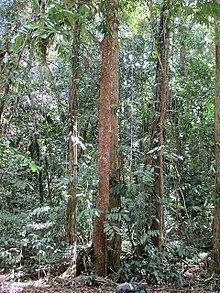Kingdom Plantae Genus Dysoxylum Order Sapindales | Family Meliaceae Rank Species | |
 | ||
Similar Dysoxylum, Lithocarpus elegans, Pyrrosia nummularifolia, Chisocheton, Mangifera laurina | ||
Dysoxylum parasiticum, known as yellow mahogany, is a species of rainforest trees in the family Meliaceae. The specific epithet parasiticum is from the Latin meaning "parasitic", referring to the now-incorrect idea that the flowers are parasitic on another tree species.
Contents
Taxonomy and naming
Swedish naturalist Pehr Osbeck described this species as Melia parasitica in 1751, before it was transferred to the genus Dysoxylum by Indonesian botanist André Joseph Guillaume Henri Kostermans in 1966. Australian populations were known as Dysoxylum schiffneri.
The Bajau people of Sabah know it as jarum-jarum, while it is commonly known as yellow mahogany in Queensland.
Description
Dysoxylum parasiticum trees grow up to 36 metres (120 ft) tall with a trunk that has a diameter of up to 60 centimetres (24 in) and up to 1.5-metre (5 ft) buttresses. The smooth bark is yellowish to grey-brown. The sweetly scented flowers are white or creamish-coloured. The red-brown fruits are roundish, and up to 4 cm (1.6 in) in diameter. Both flowers and fruits grow directly off the trunk (cauliflory) to near ground level, or off the large branches (ramiflory).
Distribution and habitat
Dysoxylum parasiticum trees grow naturally in Taiwan and throughout Malesia, to New Guinea, the Solomon Islands and Queensland. Their habitat is rainforest from sea-level to 2,100 metres (7,000 ft) altitude. In Queensland they are found from sea level to 1,400 metres (5,000 ft), in such areas in the northeast as Mount Bellenden Ker.
Uses
Dysoxylum parasiticum has potential as a feature tree in parks or gardens in areas with subtropical or tropical climates. It prefers acid soils with good drainage and dappled sun or part-shade. The species can be propagated by fresh seed.
